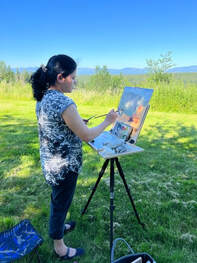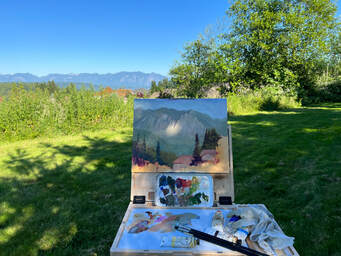 Plein Air Painting: A movement! What is plein air painting? When you visit museums and see jaw dropping landscape paintings by famous artists, do you wonder how those artists must have created them in the first place? Was it all their imagination? If you research, you will find that all paintings had their beginnings somewhere outside! You will soon realize creativity is fueled by nature. When you leave the four walls of your house and start drawing and painting directly in nature, you tune yourself to the language of nature. The practice goes back centuries. Humans have always dipped their fingers, sticks and brushes in colors and have drawn on cave walls, houses, and paper. They observed and painted outdoor scenes. In today’s world, Plein Air painting has become a movement that is over two centuries old. It was founded in France and truly made into an art form by French impressionists. They wanted to paint light and its changing qualities. As oil paints became available in convenient tubes along with portable box easel, it allowed artists freedom to paint in open air. The French word for this expression is “En Plein Air.” The Plein Air movement gave birth to many plein air painters who became very famous for their vibrant paintings. The technique was passed on by groups and organizations formed at local, state, regional and national levels across Europe and America. It has been enthusiastically supported by museums, galleries, magazines, and collectors all over the world. Let’s see how it works! Artists will need to have portable supplies and support for their painting surface. They need to be able to easily carry it when they go outdoors in search of interesting subjects. Artists study their scenes and make preliminary sketches from observation. Depending on weather and time of the day, they must face different lighting conditions, such as direct light on a sunny day, evening light, snowy days or rainy overcast skies. Different types of light display unique qualities particular to that light and artists will need to be trained to understand these qualities. Since lighting conditions can change rapidly, artists must be fast and come up with quick compositions for their painting. They need to have good control over their brush work to paint convincingly. Artists also need to be familiar with the fundamentals of drawing. Artists trained in life drawing and academic art subjects like linear perspective have huge advantages over those who are not trained. These small paintings painted outdoors as studies become sources for larger studio paintings. Now you must be thinking, how do artists go about finding subjects outdoors? Some artists find beauty in everyday life’s “mundane things”. Simple scenes in ordinary life inspires them. Some artists get inspired by dramatic lights or weather and for others, it’s any object catching their eye. Beautiful patterns of light shapes and dark shapes that create endless varieties of design and coloration intrigues some, while other artists look for more difficult subjects which challenge them to create! Some artists enjoy adventure and traveling to wonderful painting locations and meeting people along the way. For them paintings become more about a moment in time than about a particular location. Each painting reminds them of where they were, of the experiences they had, the sounds, smells, and the people they met. At the end, plein air painting is an adventure unto itself! You are training yourself to see, observe, and create 2D images of a 3D world. Although people like them for the spontaneity and looseness which their limited timeframes force, the goal is not to create finished paintings. The whole process sets you on a journey of setting intention, forcing you to make decisions and capture as much as you can in that moment. It gives you the pure joy of creation but also expresses how you feel and how you see the world. Isn’t it beautiful? As journalist and author Brenda Ueland (book: If You Want to Write – A Book about Art Independence and Spirit) says “Inspiration does not come like a bolt, nor it is a kinetic, energetic striving, but it comes into us slowly and quietly and all the time. Though we must regularly and everyday give it a little chance to start flowing, prime it with a little solitude and idleness!” I hope this stirs your enthusiasm to try and create plein air art and sets you on a journey to be a lifelong student of mother nature. By : Vinita Mohite Published article in Seattle Maharashtra Mandal 2022 Magazine.
0 Comments
Leave a Reply. |
Vinita MohiteArtist on path of discovering beauty & creativity in day today life. Archives
August 2023
Categories |


 RSS Feed
RSS Feed